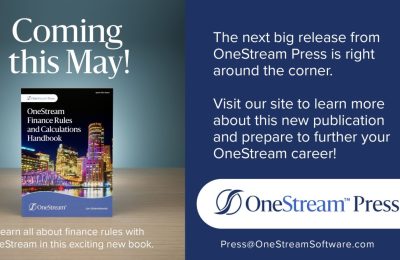This article first appeared on the OneStream blog by Nicholas Cox
For most of us, watching sci-fi films like the Avengers or the Matrix has given us a potential insight into what the future might look like. We can, therefore, imagine what’s possible and impossible for the next generations. But, we’re also seeing big shifts in what’s possible right now.
With analytics, for instance, we’re now reaching a stage where the technology available today can examine the vast amounts of data within an organisation and begin to predict what will happen next – with high degrees of accuracy.
Advanced analytics have been around for more than 20 years. What’s new, then? Why are analytic tools becoming increasingly more common today? Well, the changes in technology and the ability to integrate ever-larger volumes of data into day-to-day business processes are driving increasing interest and the desire to turn the vision of advanced analytics into reality.
Advanced analytics deliver deeper data knowledge and more granular insights. Accordingly, many more business functions now have a legitimate interest in this capability to help foster better decision-making and improved business outcomes.Gartner describes advanced analytics across four main types of capabilities (see Figure 1), which are illustrated below:

The questions in Gartner’s model (Figure 1) can be a helpful guide to understanding exactly where your organisation stands regarding the adoption of these capabilities. Most organisations have mastered the first two questions, allowing organisations to understand what happened and why. However, many organisations do not have the capabilities in place to predict what will happen.
Is there proof of this? Yes. According to the Dresner Advisory 2021 Data Science and Machine Learning Market Study, only 39% of Finance teams are deploying the kind of technologies that enable predictions about future or otherwise unknown events today. The number of organisations that can then use those technologies to help decide what to do next is much lower.
The Power of Advanced Analytics for Finance
With the sheer volume of data available and advancements in CPM software, Finance teams now (finally) have the capability to interact with advanced analytics. And do it at scale.
How? Instead of taking on the burden of building models, Finance teams can rely on purpose-built software to help supplement analysis, reporting, and planning processes with not only high-volume operational and financial signals but also statistically significant, predictive forecasts.
The following advanced analytics use cases can be found across organisations:
- Corporate FP&A – Create daily or weekly financial signals on sales, gross margin, and working capital drivers
- Sales Finance – Seed S&OP processes with predictive forecasts
- Operations Finance – Analyse future labour and material costs with predictive models
- Brand Finance – Extend predictive forecasting by store, brand, department, product category
Through data mining, machine learning (ML), statistical modeling, and other methods, advanced analytics are making industries everywhere more competitive.
Benefits of Advanced Analytics
Advanced analytics offer Finance teams a new way to drive performance – and lead at speed. If Finance teams spend all their time moving data, reconciling data and building reports, they’ll have no time to leverage the data to guide key decisions. But by leveraging technology to automate the hard work, Finance teams can shift a larger portion of their time to value-driving activities, such as forecasting cash or evaluating key capital investment decisions.
Advanced analytics tools offer a more accurate and reliable means of looking into the future than many previous tools could provide. How can that insight help organisations gain a monetary benefit? Well, retailers can use predictive models to forecast inventory requirements. Hotels, restaurants and other hospitality organisations can use the capability to forecast the number of guests on any given night to maximise occupancy and revenue. Airlines frequently use predictive analytics to set ticket prices that reflect past travel trends or account for major events.
Whatever the industry, attracting and retaining customers is important to any organisation, but advanced analytics can bring the opportunity to optimise marketing campaigns to nurture customers. In turn, new purchasing opportunities can be surfaced to deliver continuous value.
OneStream Delivers Advanced Analytics
OneStream unleashes the power of Finance by unifying planning, financial close & consolidation, reporting, and analytics through a single, extensible solution. We empower the enterprise with financial and operational insights to support faster and more informed decision-making – all in a platform designed to continually evolve and scale with the organisation.
OneStream’s comprehensive corporate performance management (CPM) software platform helps Finance teams access, maintain, validate and visualise data – all within a seamless and unified experience. And in doing so on both governed financial and high-velocity operational data, OneStream provides a foundation for Finance-owned transactional analysis, reporting and sharing predictive insights. Those insights then allow organisations to find new ways to ask ‘why’.
OneStream’s advanced analytics strategy includes key capabilities to enable Finance and business leaders. Here are a few of those capabilities:
Analytic Blend
OneStream provides a unique ability to ‘blend’ validated financial data, highly dimensional operational data, and detailed transactional data in one platform for comprehensive, controlled, and consumable analysis and visualisation. Easily combine financial, operational, and transactional data in a single dashboard for comprehensive visualisation and analysis. With Analytic Blend (See Figure 2), Finance maintains one source of the truth for data, extending access to line-of-business managers and executives while eliminating data latency and the unnecessary replication of financial data for analysis.

Predictive Analytics
OneStream empowers Finance teams to lead at speed by unifying predictive analytics with core CPM processes: planning, budgeting, and forecasting; financial consolidation; reporting; and financial data quality. And with built-in predictive analytics (see figure 3), OneStream is unleashing Finance transformation to take budgeting, planning, and forecasting processes even further – allowing teams to plan, analyse and predict with confidence.

Machine Learning
OneStream’s sensible ML solution will provide Finance teams with the power to leverage ML models without extensive work by data scientists. This solution will take users through a step-by-step process for each part of the ML model-building and deployment process. Including feature engineering through advanced algorithm configuration, training, and deployment.
Creating value from advanced analytics in Finance and beyond could make a significant difference to your organisation’s performance. What if you had the power to incorporate advanced analytics directly into your day-to-day business processes? What if you could conquer the complexity of gathering and organising financial and operational data? Or creating and maintaining predictive forecast models? Let the right technology help you to view the possible and impossible for the future of your organisation.
Learn More
If your Finance organisation is being hindered from unleashing its true value, maybe it’s time to evaluate your internal reporting & analytics and start identifying areas for improvement. To learn more, view the OneStream advanced analytics interactive e-book.Read the e-Book



